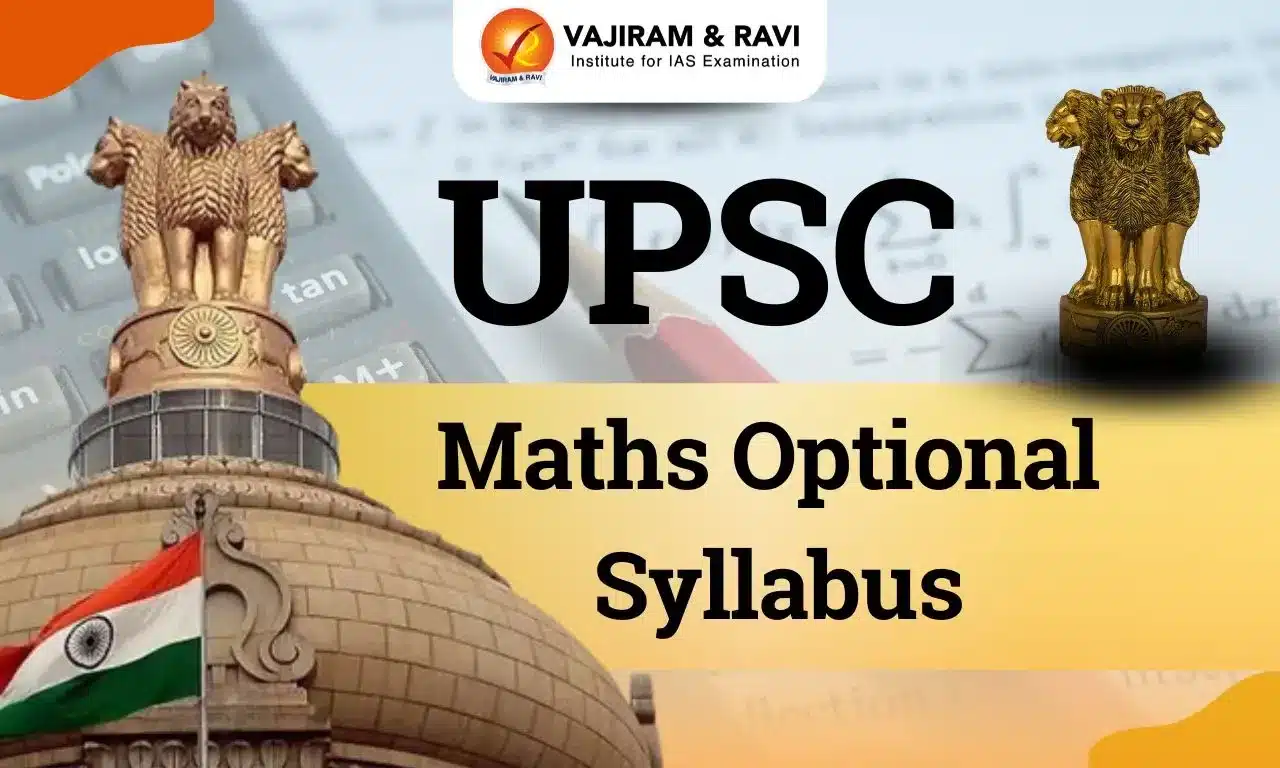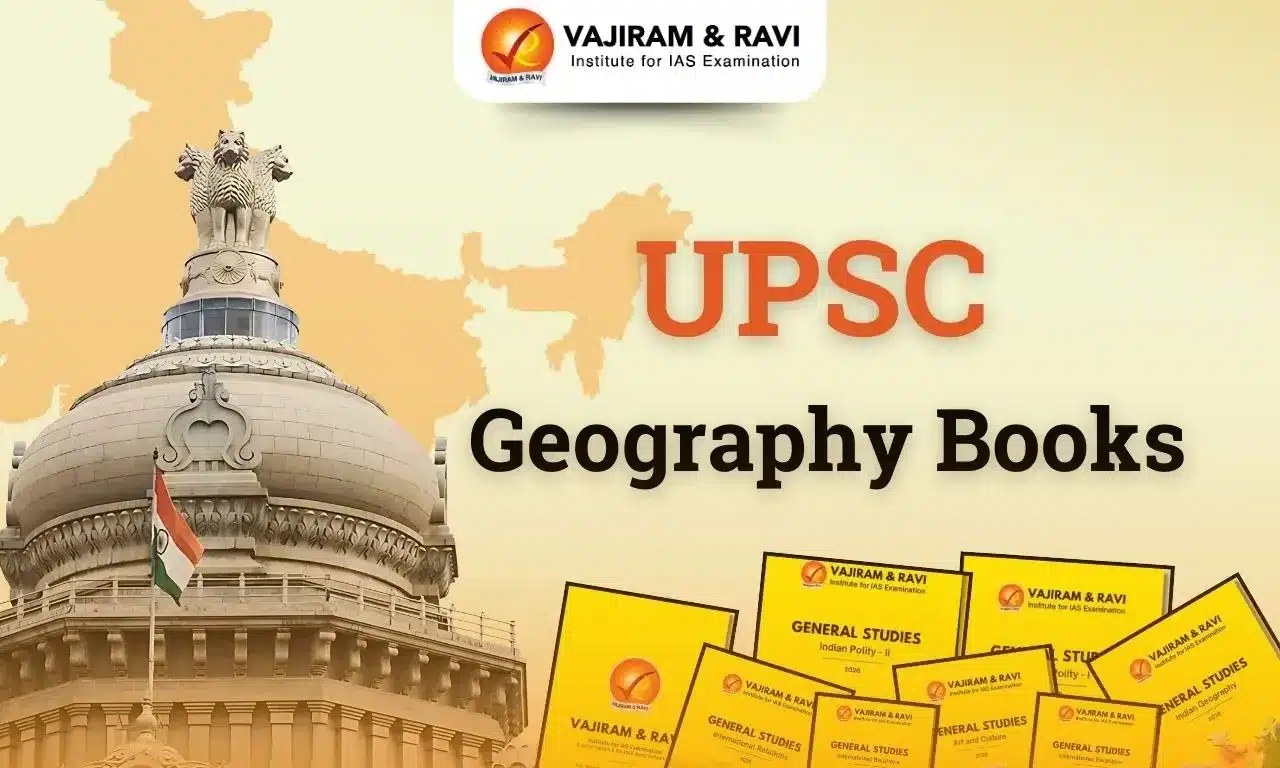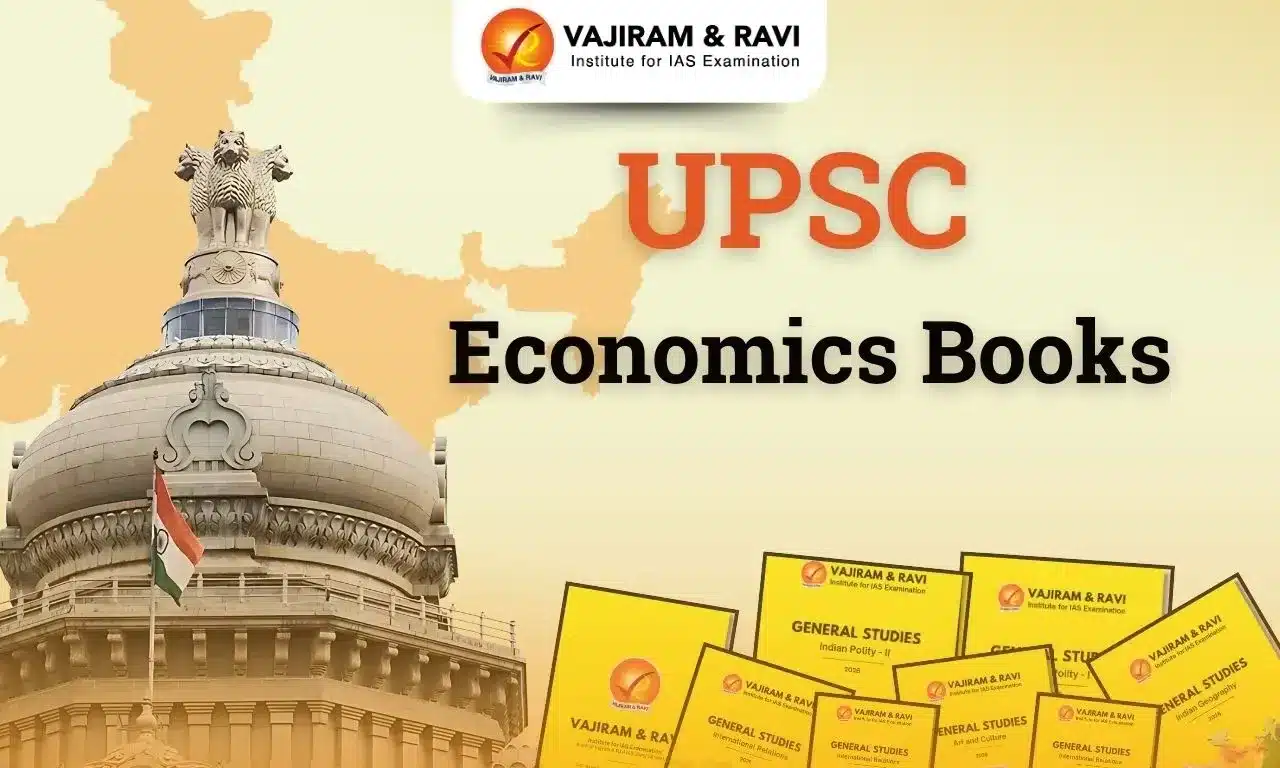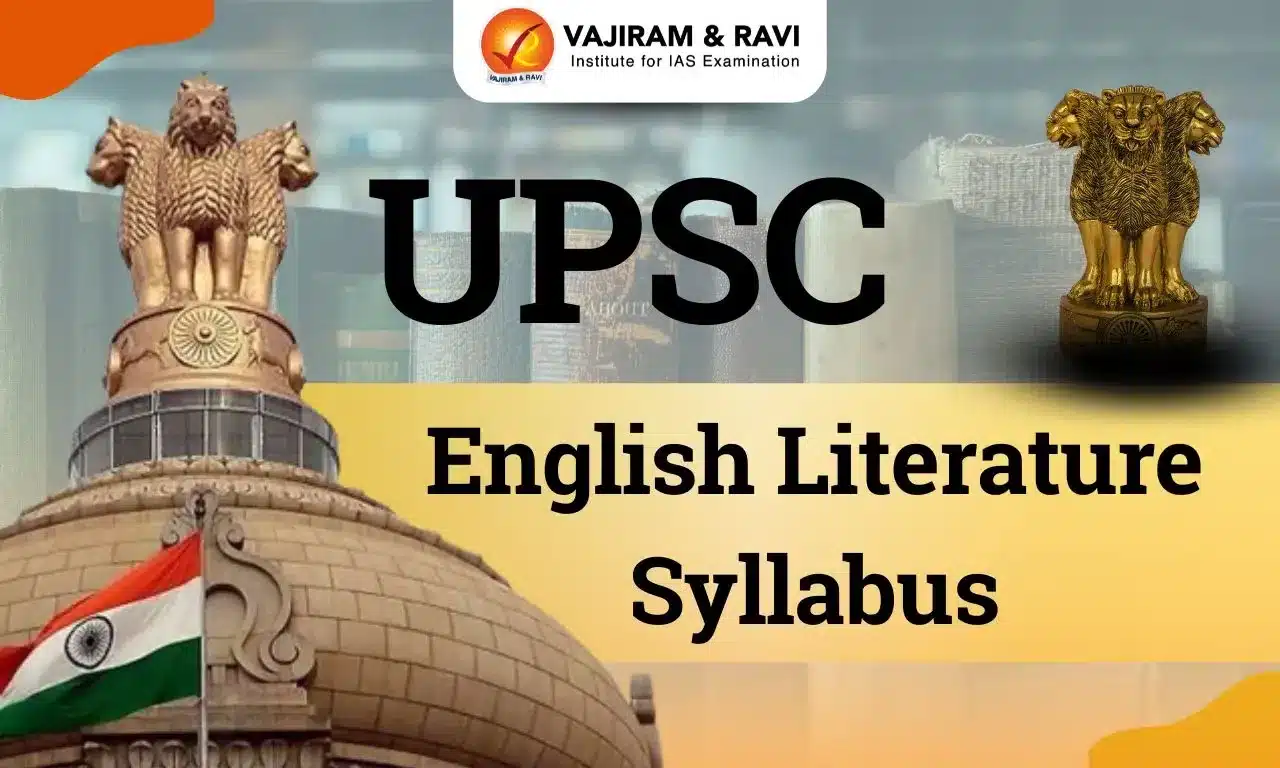The UPSC Maths Optional Syllabus contains topics from linear algebra, calculus, differential equations, analytical geometry, etc. One of the optional subjects that candidates can choose in the UPSC Mains exam is Mathematics, catering to those with a strong mathematical aptitude and a genuine passion for the subject. One of the advantages of choosing this subject is the static syllabus of Maths Optional.
In this article, we delve into the intricacies of the UPSC Maths Syllabus 2026, providing a detailed outline of the topics that candidates can expect to encounter.
UPSC Maths Syllabus 2026
Understanding Maths Syllabus is a crucial step to begin your UPSC Civil Services Examination preparation. Mathematics lays a strong foundation for higher studies in various fields, such as pure mathematics, applied mathematics, and theoretical physics. Mastering complex mathematical concepts fosters a sense of achievement and boosts self-confidence.
UPSC Mathematics Syllabus for Optional Paper 1
UPSC CSE Maths Optional Paper 1 has a weightage of 250 marks. The order of the topics in the UPSC Maths syllabus is Linear Algebra, Calculus and Analytic geometry (Section A), followed by Ordinary Differential Equations, Vector Analysis and Dynamics and Statics (Section B).
| SECTION A | |
| Linear Algebra | Vector spaces over R and C, linear dependence and independence, subspaces, bases, dimensions, Linear transformations, rank and nullity, matrix of a linear transformation. Algebra of Matrices; Row and column reduction, Echelon form, congruence’s and similarity; Rank of a matrix; Inverse of a matrix; Solution of system of linear equations; Eigenvalues and eigenvectors, characteristic polynomial, Cayley-Hamilton theorem, Symmetric, skew-symmetric, Hermitian, skew-Hermitian, orthogonal and unitary matrices and their eigenvalues. |
| Calculus | Real numbers, functions of a real variable, limits, continuity, differentiability, mean-value theorem, Taylor’s theorem with remainders, indeterminate forms, maxima and minima, asymptotes; Curve tracing; Functions of two or three variables; Limits, continuity, partial derivatives, maxima and minima, Lagrange’s method of multipliers, Jacobian. Riemann’s definition of definite integrals; Indefinite integrals; Infinite and improper integral; Double and triple integrals (evaluation techniques only); Areas, surface and volumes. |
| Analytic Geometry | Cartesian and polar coordinates in three dimensions, second degree equations in three variables, reduction to Canonical forms; straight lines, shortest distance between two skew lines, Plane, sphere, cone, cylinder, paraboloid, ellipsoid, hyperboloid of one and two sheets and their properties. |
| SECTION B | |
| Ordinary Differential Equations | Formulation of differential equations; Equations of first order and first degree, integrating factor; Orthogonal trajectory; Equations of first order but not of first degree, Clairaut’s equation, singular solution. Second and higher order linear equations with constant coefficients, complementary function, particular integral and general solution. Second order linear equations with variable coefficients, Euler-Cauchy equation; Determination of complete solution when one solution is known using method of variation of parameters. Laplace and Inverse Laplace transforms and their properties, Laplace transforms of elementary functions. Application to initial value problems for 2nd order linear equations with constant coefficients. |
| Vector Analysis | Scalar and vector fields, differentiation of vector field of a scalar variable; Gradient, divergence and curl in cartesian and cylindrical coordinates; Higher order derivatives; Vector identities and vector equation. Application to geometry: Curves in space, curvature and torsion; Serret-Frenet's formulae. Green’s, Gauss and Stokes’ theorems. |
| Dynamics and Statics | Rectilinear motion, simple harmonic motion, motion in a plane, projectiles; Constrained motion; Work and energy, conservation of energy; Kepler’s laws, orbits under central forces. Equilibrium of a system of particles; Work and potential energy, friction, Common catenary; Principle of virtual work; Stability of equilibrium, equilibrium of forces in three dimensions. |
UPSC Maths Optional Syllabus 2026 for Paper 2
Just like Maths Paper-1, Maths Optional Paper-2 also has a weightage of 250 Marks.
The order here should be Modern Algebra, Real Analysis, Complex Analysis and Linear Programming (Section A) followed by Partial Differential Equations, Numerical Analysis and Computer Programming and Mechanics and Fluid Dynamics.
| SECTION A | |
| Modern Algebra | Groups, subgroups, cyclic groups, cosets, Lagrange’s Theorem, normal subgroups, quotient groups, homomorphism of groups, basic isomorphism theorems, permutation groups, Cayley’s theorem. Rings, subrings and ideals, homomorphisms of rings; Integral domains, principal ideal domains, Euclidean domains and unique factorization domains; Fields, quotient fields. |
| Real Analysis | Real number system as an ordered field with least upper bound property; Sequences, limit of a sequence, Cauchy sequence, completeness of real line; Series and its convergence, absolute and conditional convergence of series of real and complex terms, rearrangement of series. Continuity and uniform continuity of functions, properties of continuous functions on compact sets. Riemann integral, improper integrals; Fundamental theorems of integral calculus. Uniform convergence, continuity, differentiability and integrability for sequences and series of functions; Partial derivatives of functions of several (two or three) variables, maxima and minima. |
| Complex Analysis | Analytic function, Cauchy-Riemann equations, Cauchy's theorem, Cauchy's integral formula, power series, representation of an analytic function, Taylor’s series; Singularities; Laurent’s series; Cauchy’s residue theorem; Contour integration. |
| Linear Programming | Linear programming problems, basic solution, basic feasible solution and optimal solution; Graphical method and simplex method of solutions; Duality. Transportation and assignment problems. |
| SECTION B | |
| Partial Differential Equations | Family of surfaces in three dimensions and formulation of partial differential equations; Solution of quasilinear partial differential equations of the first order, Cauchy’s method of characteristics; Linear partial differential equations of the second order with constant coefficients, canonical form; Equation of a vibrating string, heat equation, Laplace equation and their solutions. |
|
Numerical Analysis And Computer Programming |
Numerical methods: solution of algebraic and transcendental equations of one variable by bisection, Regula-Falsi and Newton-Raphson methods; solution of system of linear equations by Gaussian elimination and Gauss-Jordan (direct), Gauss-Seidel(iterative) methods. Newton’s (forward and backward) interpolation, Lagrange’s interpolation. Numerical integration: Trapezoidal rule, Simpson’s rules, Gaussian quadrature formula. Numerical solution of ordinary differential equations: Euler and Runge Kutta-methods. Computer Programming: Binary system; Arithmetic and logical operations on numbers; Octal and Hexadecimal systems; Conversion to and from decimal systems; Algebra of binary numbers. Elements of computer systems and concept of memory; Basic logic gates and truth tables, Boolean algebra, normal forms. Representation of unsigned integers, signed integers and reals, double precision reals and long integers. Algorithms and flow charts for solving numerical analysis problems. |
| Mechanics and Fluid Dynamics | Generalised coordinates; D’Alembert’s principle and Lagrange’s equations; Hamilton equations; Moment of inertia; Motion of rigid bodies in two dimensions. Equation of continuity; Euler’s equation of motion for inviscid flow; Stream-lines, path of a particle; Potential flow; Two-dimensional and axisymmetric motion; Sources and sinks, vortex motion; Navier-Stokes equation for a viscous fluid. |
Benefits of Choosing Mathematics as an Optional Subject
Taking Mathematics as an optional subject offers several benefits:
- Scoring Potential: Mathematics is often regarded as a scoring subject, allowing students to secure high marks and boost their overall exam scores. Being highly objective in nature, higher scores are possible compared to subjective papers.
- Analytical Skills: Studying Mathematics enhances analytical and logical thinking abilities, which are valuable for problem-solving in various fields.
- Complementary Subject: Mathematics complements other subjects like physics, chemistry, and economics, enhancing the understanding of complex concepts.
- Competitive Exams: Mathematics is a common subject in competitive exams like civil services, engineering entrance tests, and management exams, providing an advantage to students who are well-versed in the subject.
- Problem-Solving Skills: Studying mathematics improves critical thinking and problem-solving skills, which are valuable in everyday life and professional settings.
- Logical Reasoning: It develops logical reasoning, enabling students to approach challenges in a structured and organised manner.
Overall, taking mathematics as an optional subject can prove to be advantageous for academic, professional, and personal development, offering valuable skills that can be applied throughout life.
UPSC Maths Optional Syllabus Preparation Strategy
UPSC aspirants often prefer Maths Optional, especially engineering students, due to its objective syllabus. Here are some tips to help you prepare the UPSC Maths Optional syllabus efficiently:
- Build Conceptual Understanding: Prioritise developing a clear understanding of each topic mentioned in the UPSC Maths Optional syllabus.
- Optimal Revision: Allocate fixed time for regular revision to retain information effectively. Solve UPSC previous year papers and mock tests.
- Master Answer-Writing: Focus on effective presentation in UPSC answer-writing. Learn from toppers' answer scripts or get your answers evaluated by mentors.
- Emphasise Logical Flow: Avoid cramming mathematics; instead, focus on building a logical flow to solve different types of questions in the exam.
- Formula Sheet: Maintain a separate formula sheet or notebook with all essential formulas and theorems. Regularly revise it to avoid forgetting important information.
- Minimise Mistakes: Practice extensively to reduce the chances of making silly mistakes while solving questions.
By following these strategies, you can enhance your preparation and excel in the UPSC Maths Optional paper.
Books to Study for UPSC Mathematics Optional Syllabus 2026
For the UPSC Maths Optional, there are a number of Books that you can refer to:
Maths Paper 1:
LINEAR ALGEBRA
- SCHAUM SERIES - Seymour Lipschutz
- LINEAR ALGEBRA - Hoffman and Kunze
- CALCULUS
- MATHEMATICAL ANALYSIS - S C Malik and Savita Arora
- ELEMENTS OF REAL ANALYSIS - Shanti Narayan and M D Raisinghania
- ANALYTIC GEOMETRY
- ANALYTICAL SOLID GEOMETRY - Shanti Narayan and P K Mittal
- SOLID GEOMETRY - P N Chatterjee
- ORDINARY DIFFERENTIAL EQUATIONS (ODE)
- ORDINARY AND PARTIAL DIFFERENTIAL EQUATIONS - M D Raisinghania
- DYNAMICS AND STATICS
- KRISHNA SERIES
- VECTOR ANALYSIS
- SCHAUM SERIES - Murray R. Spiegel
Maths Paper 2:
- ALGEBRA - CONTEMPORARY ABSTRACT ALGEBRA - Joseph Gallian
- REAL ANALYSIS - SAME AS CALCULUS OF PAPER 1
- COMPLEX ANALYSIS
- SCHAUM SERIES - Speigel, Lipschitz, Schiller, Spellman
- LINEAR PROGRAMMING
- LINEAR PROGRAMMING AND GAME THEORY - Lakshmishree Bandopadhyay
- PARTIAL DIFFERENTIAL EQUATIONS
- SAME AS ODE OF PAPER 1
- ADVANCED DIFFERENTIAL EQUATIONS - M D Raisinghania
- NUMERICAL ANALYSIS AND COMPUTER PROGRAMMING
- For Numerical Analysis
- COMPUTER BASED NUMERICAL AND STATISTICAL TECHNIQUES - M.Goyal
- NUMERICAL METHODS - Jain, Iyengar and Jain
- FOR COMPUTER PROGRAMMING
- DIGITAL LOGIC AND COMPUTER DESIGN - M. Morris Mano
- MECHANICS AND FLUID DYNAMICS
- KRISHNA SERIES
How to Approach UPSC Maths Optional Syllabus?
The Mathematics optional syllabus, like all other optional subjects, is divided into two papers, further bifurcated into two sections each. The preparation, however, must not be done paperwise or sectionwise. The best strategy is to remember which topics should be done consecutively or at least in the vicinity of the other. You may start from any topic, but the following combinations must be adhered to. One must do Ordinary Differential Equations (ODE) and Partial Differential Equations (PDE) in sync with each other. Not only is there a link between the two conceptually, but there is also overlap in terms of some methods. Moreover, the book is also common (Ordinary and partial differential equations by MD Raisinghnaia).
Next, one must always prepare Real Analysis and Calculus simultaneously. This is imperative also from the point of view of the UPSC Maths syllabus as there are some topics like Riemann integration or improper integrals, which are covered in both. Linear Algebra, especially the vector spaces portion, must be tuned with Abstract algebra as a sound clarity about properties of groups and rings (specifically fields) helps to do theorems in a more logical and structured manner.
Then, one must keep in mind to do Vector calculus before doing the Physics topics as it forms the backbone of the same. Complex Analysis similarly must be done after real analysis. Even though some topics like Gauss elimination, Gauss Seidel etc. are more or less covered in Linear Algebra, Numerical Analysis may be done independently. Likewise, linear programming can also be done more or less without support from other topics, though it is preferable to do both after linear algebra. Since 3-dimensional geometry is also not required in-depth for others, Analytic geometry may be done without keeping any order in mind.
| Other Related UPSC Optional Syllabus | ||
|---|---|---|
|
UPSC Animal Husbandry & Veterinary Science Optional Syllabus |
|
|
Last updated on November, 2025
→ Check out the latest UPSC Syllabus 2026 here.
→ Join Vajiram & Ravi’s Interview Guidance Programme for expert help to crack your final UPSC stage.
→ UPSC Mains Result 2025 is now out.
→ UPSC Notification 2026 is scheduled to be released on January 14, 2026.
→ UPSC Calendar 2026 is released on 15th May, 2025.
→ The UPSC Vacancy 2025 were released 1129, out of which 979 were for UPSC CSE and remaining 150 are for UPSC IFoS.
→ UPSC Prelims 2026 will be conducted on 24th May, 2026 & UPSC Mains 2026 will be conducted on 21st August 2026.
→ The UPSC Selection Process is of 3 stages-Prelims, Mains and Interview.
→ UPSC Result 2024 is released with latest UPSC Marksheet 2024. Check Now!
→ UPSC Prelims Result 2025 is out now for the CSE held on 25 May 2025.
→ UPSC Toppers List 2024 is released now. Shakti Dubey is UPSC AIR 1 2024 Topper.
→ UPSC Prelims Question Paper 2025 and Unofficial Prelims Answer Key 2025 are available now.
→ UPSC Mains Question Paper 2025 is out for Essay, GS 1, 2, 3 & GS 4.
→ UPSC Mains Indian Language Question Paper 2025 is now out.
→ UPSC Mains Optional Question Paper 2025 is now out.
→ Also check Best IAS Coaching in Delhi
UPSC Maths Optional Syllabus FAQs
Q1. What is the syllabus of maths in UPSC?+
Q2. Which level of maths comes in UPSC?+
Q3. Is maths hard for UPSC?+
Q4. Can I crack IAS without maths?+
Q5. Can I crack IAS if I am weak in maths?+

















